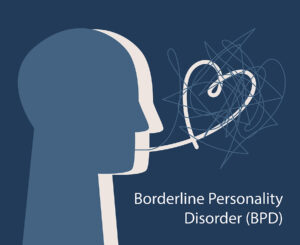Living with Borderline Personality Disorder (BPD) can be an emotional rollercoaster. The intense mood swings, unstable relationships, and self-image struggles can be overwhelming. However, there’s hope. BPD therapy online offers a lifeline to those seeking effective treatment in the comfort of their own homes. In this blog, we will delve into the world of online therapy for BPD, exploring its benefits and considerations.
Contents
Understanding Borderline Personality Disorder (BPD)

Before delving into therapy, it’s crucial to grasp what BPD is. BPD is a complex mental health condition characterized by unstable emotions, self-identity, and interpersonal relationships. Individuals with BPD often struggle with impulsivity and intense fear of abandonment.
This can lead to tumultuous relationships, impulsive behaviors, and a sense of inner turmoil. Therapy is a cornerstone of BPD treatment, and it can provide individuals with the skills and strategies to manage their symptoms effectively.
The Importance of BPD Therapy
BPD therapy is a cornerstone in managing this disorder. It equips individuals with coping mechanisms and strategies to lead fulfilling lives. Here are some reasons why it is important:
- Accessibility and Reach: One of the most critical aspects of online therapy for BPD is its accessibility. BPD often involves intense emotions and fear of abandonment, which can make it difficult for individuals to seek help in person. Online therapy eliminates geographical barriers, making it possible for individuals to access specialized treatment and qualified therapists no matter where they are located. This expanded reach can be a lifeline for those who might not otherwise have access to appropriate care.
- Reducing Stigma: The stigma associated with mental health issues can be a significant barrier to seeking treatment. Many individuals with BPD may be hesitant to seek help due to fear of judgment or discrimination. Online therapy offers a degree of anonymity and privacy that can help reduce the stigma associated with seeking mental health support. This can encourage more people to take the crucial step of seeking help for their BPD.
- Specialized Expertise: BPD is a complex disorder that requires specialized therapeutic approaches. Online therapy allows individuals to connect with therapists who have expertise in BPD treatment. This specialization can make a substantial difference in the effectiveness of therapy. These therapists understand the unique challenges of BPD and can tailor their interventions accordingly, offering evidence-based techniques such as Dialectical Behavior Therapy (DBT).
- Flexibility and Convenience: Online therapy provides flexibility in scheduling and communication. This flexibility is vital for individuals with BPD, as their symptoms can fluctuate, and they may need support at different times. The ability to schedule sessions at convenient times and choose from various communication modes (video, chat, or phone) can enhance the therapeutic experience, making it more effective and less stressful for individuals with BPD.
- Comfort and Safety: Being in a familiar environment can make individuals feel more comfortable and safe during therapy sessions. This can promote openness and honesty in discussions, which is essential for effective treatment.
Techniques in Online BPD Therapy

There are various therapeutic approaches tailored to BPD:
- Dialectical Behavior Therapy (DBT)DBT is a well-established therapeutic approach specifically designed for individuals with BPD. Online therapists often use DBT techniques to help clients develop mindfulness, emotional regulation, distress tolerance, and interpersonal effectiveness skills. Clients are taught how to identify and manage intense emotions, reduce impulsive behavior, and navigate interpersonal conflicts.
- Mindfulness and Grounding ExercisesMindfulness is a core component of DBT and many other therapeutic approaches for BPD. Online therapists may guide clients through mindfulness exercises to help them stay present in the moment, observe their thoughts and emotions without judgment, and reduce impulsivity. Grounding techniques, such as the 5-4-3-2-1 exercise, can also help clients manage overwhelming emotions by connecting them to their immediate surroundings.
- Emotion Regulation StrategiesBPD often involves intense and rapidly shifting emotions. Online therapists may work with clients to develop emotion regulation skills. This includes identifying emotional triggers, using coping strategies like deep breathing, and creating emotion regulation plans to manage emotional crises.
- Interpersonal Effectiveness SkillsIndividuals with BPD may struggle with interpersonal relationships. Online therapy can help clients learn effective communication, assertiveness, and boundary-setting skills. Therapists may use role-playing exercises and real-life scenarios to practice these skills in a safe and supportive environment.
- Cognitive-behavioral therapy (CBT)CBT techniques are often incorporated into online BPD therapy to help clients challenge and reframe negative thought patterns and beliefs. This can be particularly beneficial for addressing self-esteem issues and reducing self-destructive behaviors.
- Schema-Focused TherapySchema-focused therapy aims to identify and address deep-seated schemas or core beliefs that underlie maladaptive behavior in individuals with BPD. Online therapists may help clients explore these schemas and work on changing them through cognitive restructuring and experiential techniques.
Finding the Right Online BPD Therapy
Finding the right online therapy for Borderline Personality Disorder (BPD) involves careful consideration and research. Here are steps to help you find the most suitable online BPD therapy:
- Assess Your Needs: Start by assessing your specific needs and preferences. Consider your goals for therapy, the type of therapy that may work best for you (e.g., Dialectical Behavior Therapy, Schema Therapy), and your availability for sessions.
- Seek Professional Guidance: Consult with a mental health professional, such as a psychiatrist or psychologist, who specializes in BPD. They can provide recommendations and help you understand what type of therapy may be most effective for your condition.
- Search for Reputable Online Platforms: Look for reputable online therapy platforms or websites that offer BPD therapy services. Some well-known platforms include Mantracare and Therapymantra. Ensure that the platform complies with privacy and security standards.
- Check Therapist Credentials: Verify the credentials of therapists on the platform. Ensure they are licensed mental health professionals with experience in treating BPD. Look for therapists who are trained in evidence-based BPD therapies like DBT or Schema Therapy.
- Read Reviews and Testimonials: Read reviews and testimonials from other individuals who have used the platform or worked with the therapists. Pay attention to both positive and negative feedback to get a balanced perspective.
- Assess Pricing and Insurance: Consider your budget and whether your insurance covers online therapy services. Compare the costs of therapy on different platforms and check if any financial assistance or sliding-scale fees are available.
- Evaluate Communication Methods: Determine what communication methods the platform or therapist offers. This could include video calls, phone calls, chat, or email. Choose a format that you are comfortable with and that meets your needs.
Starting Your Online BPD Therapy Journey
Starting your online therapy journey for Borderline Personality Disorder (BPD) can be a significant step toward improving your mental health and overall well-being. Here are steps to help you begin your online BPD therapy journey:
- Self-Assessment: Begin by reflecting on your needs and goals for therapy. What specific symptoms or challenges related to BPD are you hoping to address? Understanding your objectives will help guide your therapy journey.
- Research: Research different online therapy platforms and providers that offer services for BPD. Look for reputable platforms with licensed therapists who specialize in BPD or related treatments, such as Dialectical Behavior Therapy (DBT) or Schema Therapy.
- Consult a Mental Health Professional: If you have access to a mental health professional, consult with them to discuss your decision to start online therapy. They can provide guidance, assess your needs, and offer recommendations for suitable therapists or platforms.
- Choose a Platform or Provider: Select an online therapy platform or provider that aligns with your preferences and needs. Consider factors such as the types of therapy offered, therapist credentials, pricing, and communication methods (e.g., video calls, chat).
- Create an Account: Sign up for an account on the chosen online therapy platform. You may need to provide personal information and complete an initial assessment to match you with a suitable therapist.
- Therapist Selection: After completing the assessment, the platform will typically match you with a therapist. Review the therapist’s profile and credentials, and if you feel comfortable with the match, proceed. If not, some platforms allow you to request a different therapist.
- Set Up an Initial Session: Schedule your first therapy session. This may involve choosing a convenient date and time for a video call or chat session. The initial session is an opportunity to discuss your goals, concerns, and expectations.
Overcoming Challenges in BPD Therapy

Overcoming challenges in Borderline Personality Disorder (BPD) therapy is a crucial part of the recovery process. BPD therapy can be effective, but it often involves facing various obstacles along the way. Here are some common challenges and strategies to overcome them:
Fear of Abandonment: Many individuals with BPD have a deep-seated fear of abandonment, which can affect the therapeutic relationship. This fear may lead to idealizing or devaluing the therapist.
- Strategy: Communicate openly with your therapist about these feelings. Discussing your fears and working together to establish trust can be an essential part of therapy.
Emotional Dysregulation: BPD is characterized by intense emotions that can be difficult to manage. Emotional dysregulation can disrupt therapy sessions.
- Strategy: Learn and practice emotional regulation techniques taught in therapy, such as mindfulness, grounding exercises, and distress tolerance skills. These techniques can help you manage intense emotions both inside and outside of therapy.
Impulsivity: Impulsive behaviors, such as self-harm or substance abuse, are common in individuals with BPD and can interfere with therapy progress.
- Strategy: Work with your therapist to develop a safety plan for managing impulses. Explore healthier coping mechanisms and strategies to delay acting on impulsive urges.
Conclusion
Online BPD therapy is a valuable resource for those seeking to regain control of their lives. With the right therapist and dedication, you can embark on a journey towards healing and emotional stability. Don’t let BPD define you; take the first step toward recovery today.
If you are looking for an affordable Online Therapy TherapyMantra can help: Book a trial Online therapy session.


